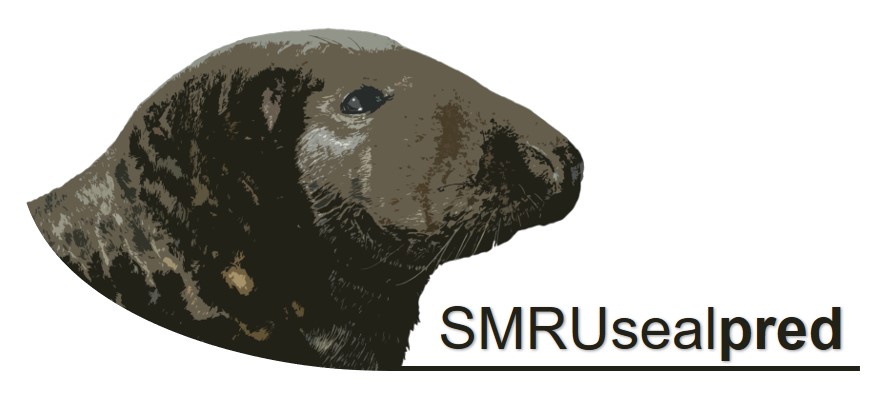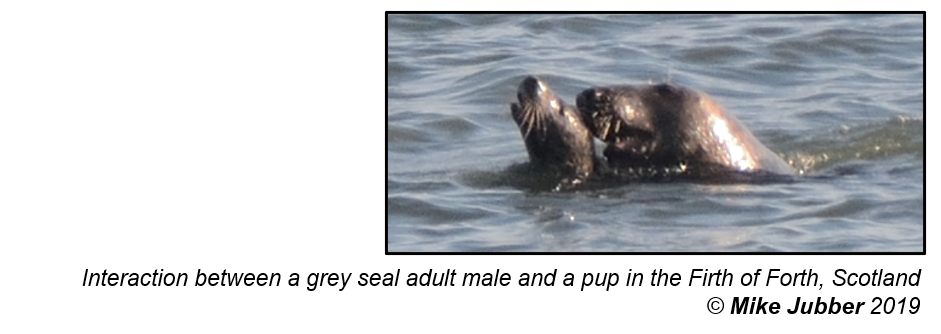
Grey seal predation - what is it and how can you help?
Both in the UK and overseas, some individual grey seal males kill and feed on marine mammals (including grey seals, harbour seals and harbour porpoises). We need your help to understand more about this behaviour and how common it is. If you have seen any strange interactions between grey seals and marine mammals, please let us know about it!
Please note, if you have found a dead seal in the UK, please report these directly to the appropriate organisation. In Scotland, this is The Scottish Marine Animal Strandings Scheme (SMASS) and in England & Wales is the UK Cetacean Strandings Investigation Programme (CSIP).
This information increases our understanding of the relative prevalence of different causes of death such as starvation, disease or predation.
See here for more information about the project.
Whilst grey seal population numbers are stable or increasing, harbour seal populations have declined in areas along the north and east of Scotland (report to the Special Committee on Seals). The Sea Mammal Research Unit (SMRU), in collaboration with The University of Aberdeen, The Scottish Marine Animal Stranding Scheme (SMASS) and others, is exploring the potential role that grey seals are having on the observed regional decline of harbour seals.
As part of this project, we are investigating predatory interactions between seals and other marine animals; particularly grey seals, harbour seals and harbour porpoises. Grey seals in the Northeast Atlantic have been reported to predate on grey seal pups (Brownlow et al. 2016), juvenile harbour seals (van Neer et al. 2015) and juvenile harbour porpoises (Leopold et al. 2015). Although our focus is on the UK, we are working with international collaborators to understand the prevalence and spatial patterns of this behaviour so would like to hear from you no matter where you are in the world!
The Scottish Marine Animal Strandings Scheme (SMASS), along with the UK Cetacean Strandings Investigation Programme (CSIP), have collected a wealth of data over the years of grey seal inflicted mortality on harbour seals. To complement this dataset, we are interested in:
- How many individual grey seals are marine mammal predators? We can identify individual grey seals using photographic identification of natural markings. This will allow us to estimate the minimum number of perpetrators within a population, and the geographical range of this behaviour.
- How many grey seal predation events are we missing from the strandings data alone? Previously, unless a carcass washed up on shore and was reported to the strandings networks, grey seal attempted predation or predation events went unmonitored. We are interested in the photographic and video evidence of aggressive interactions between grey seals and marine mammals, which could lead to, or have already resulted in a predation event.
Distinguishing grey and harbour seals can be difficult, especially when they are in the water. The Sea Mammal Research Unit have a helpful guide.
Before submitting a report, please ensure you are familiar with the Participant Information Sheet.
N.B. The usual sighting form is currently unavailable. If you would still like to report a sighting, please send the details to SMRUsealreports@st-andrews.ac.uk. The standard information and questions from the form are given below as a guide. (“*” indicates what was a required field.)
The University of St Andrews attaches high priority to the ethical conduct of research. We therefore ask you to consider the following points before submitting your sightings. Clicking “submit” confirms that you are willing to participate in this study.
If you have any problems filling in this form or would like more information please contact SMRUsealreports@st-andrews.ac.uk
By submitting this form I agree to the following:
- I understand the contents of the Participant Information Sheet.
- I have been given the opportunity to ask questions about the study (via email/phone) and have had them answered satisfactorily.
- I understand that, after 24 hours following submission, I will not be able withdraw my data as after this period we will catalogue an anonymised version of the data and may share it (e.g. with collaborators).
- I agree to take part in the above study.
- I agree to any image/video files submitted being used for the current and/or future research studies without further consultation.
By submitting my contact details (optional), I agree to being contacted with regard to the report, additional media or with further information (if requested).
Sighting
- Date of sighting*:
- Approximate time of sighting*:
- County*:
- Location*:
- (name of beach/ path/ nearest town)
- what3words:
- (e.g. https://what3words.com/correctly.yell.tunes)
- Do you regularly visit the area?
- (This gives an indication of how common the behaviour is, and how much observation effort there is in different areas.)
- Yes
- No
- Prefer not to say
- Date of sighting*:
Aggressor(s)/perpetrator(s)
- Number of aggressor(s):
- 1
- 2
- 3+
- 2
- Sex:
- Male
- Female
- Unknown
- Female
- Estimate of age:
- Pup
- Juvenile
- Adult
- Unknown
- Juvenile
- Identifying features/injuries:
- Number of aggressor(s):
Victim(s)
- Species:
- Grey seal
- Harbour/common seal
- Unknown seal species
- Harbour porpoise
- Other
- Harbour/common seal
- Sex:
- Male
- Female
- Unknown
- Female
- Estimate of age:
- Pup/calf
- Juvenile
- Adult
- Unknown
- Juvenile
- Identifying features/injuries:
- Species:
Behaviour
- Behaviour observed:
- Splash
- Chase
- Growl
- Lunge
- Bite
- Hold
- Kill
- Other
- Chase
- Outcome:
- Escape
- Injury
- Death – no carcass visibly washed up
- Death – carcass visible on land
- Unknown
- Other:
- Injury
- Approximate length of time of interaction:
- Additional information:
- Behaviour observed:
Reporter [optional]
- Name:
- Email:
- Do you have media of the event that you could share for research purposes? *
- Photo(s)
- Video(s)
- Photo(s) and video(s)
- No
- Would you be happy for this media to be used in SMRU publications/presentations*?
- (any media shared with us would be fully credited – unless you would prefer to remain anonymous)
- Yes – with credit
- Yes – anonymised
- No
- Do you have media of the event that you could share for research purposes? *
- Name:
Media
- Please either attach smaller filles and/or send futher details of any high-resolution media files that you would be willing to supply.
As the project progresses, we will post updates on our findings here. Watch this space!
You may also be interested in another SMRU project which is investigating interactions between seals and killer whales with the help of citizen science. To learn more, head to the ECOPredS website.






